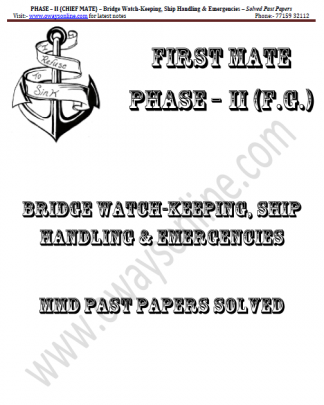Q. Describe the various methods of carrying out damage control after collision, to restore the structural integrity of ships temporarily. State the legal aspect to be followed.
Ans:- Damage survey by the vessel hands and emergency measures:
- Survey collision damage, (later) prepare a rough sketch of the damage and inspect the cargo for damage/confirm content in cargo tanks.
- Sound tanks and bilges in affected areas.
- If any flooding, close watertight doors and openings and start discharging operation. If the breakage is small, take waterproofing measures (using blankets, tarpaulins, cement box, wooden plugs, shoring and the like).
- In serious flooding in E/R, use Bilge Injection system.
- Isolate cargo, fuel, and ballast pipeline sources to affected areas of vessel.
- If the breakage is above waterlines, take waterproofing measures against sea spray.
- If the breakage is on the Fore Peak Tank, adjust speed so that excessive pressure will not be applied to the collision bulkhead.
- Consider filling opposite end tank to offset list/trim caused by flooding
- Compare the flooding rate with the discharging capacity.
- If flooding rate is greater, consider the possibility of loss of buoyancy.
- If loss of buoyancy is likely to occur, consider where to intentionally strand the vessel.
Confirming details on the other ship: Ships name, type, gross tonnage, Masters name, Ship owner and operator Port of registry, Cargo, last port and next port.
Securing Document for Evidence:-
- It is often demanded to submit the originals of the following documents to the authorities, so make their copies at an early stage. Consult with the Company before submission).
- Charts and the deck logbook/bell book
- Record paper for the course recorder. (Since replacing paper usually produces a time lag of one to two minutes, it is recommended to affix on the paper the time of its removal for easier check of the time in the future).
- Record paper for the telegraph logger and the bell book.
- Capture the Voyage Data Recorder data
- STCW records of working and rest hours of Master, officers and crew on duty
- Drug & Alcohol Test of involved ships personnel
- Statement of fact by pilot if on board.
Various Investigations:-
- Access control as per SSP must be maintained at all times.
- Render full cooperation in the investigations by lawyers, surveyors, P&I correspondents who are appointed for own vessel.
- Reject investigation by the opponent surveyor unless permitted by Company. However, surveys on hull and cargo (known as W.P. survey) are permitted but limited to only checking extent of damages and no more.
- Master should fully cooperate with interviews by a Flag or Coastal State Administration by giving them honest and accurate answers (or such signed statement).
- NO statements to the media shall be given by the vessels except with company permission.
- Safest – Politely refer media to Company.
